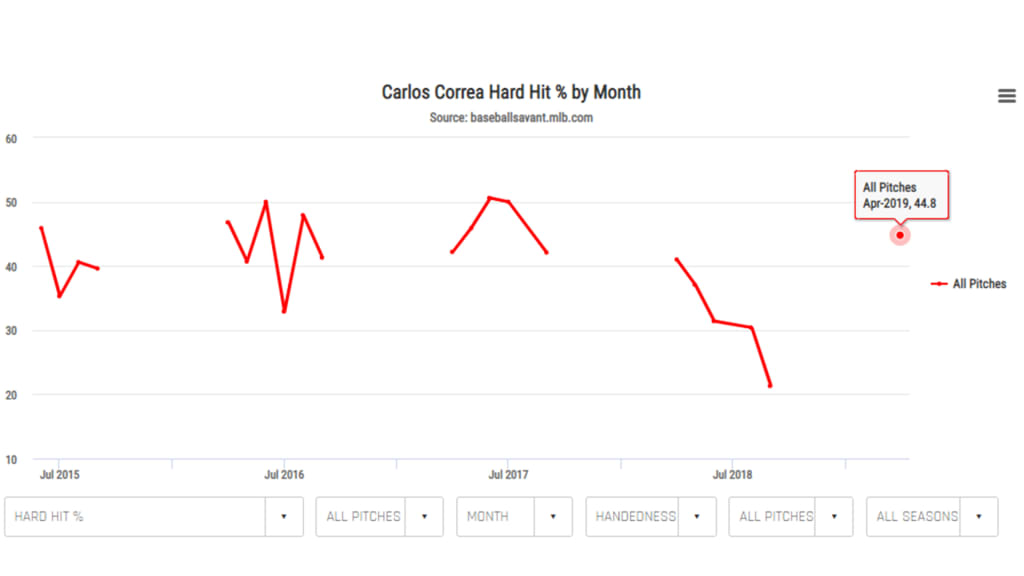SEATTLE -- Carlos Correa is astutely aware of his precise exit velocity of each ball he barrels. The Astros' shortstop inquires the club’s analytics staff following each game to put numerical context to what he’s feeling at the plate.
That’s what added mental anguish to his injury-plagued 2018.
Even after returning from a six-week stint on the injured list with lower back soreness -- pain that directly correlated with his bat speed -- Correa’s readings were well off his elite quotas.
A nearly 50-percent line-drive hitter between his 2015 American League Rookie of the Year Award season and his injured list stint last June, Correa laced liners and fly balls in that span with an average exit velocity of 94.8 mph, just under the 95-mph threshold that Statcast quantifies as hard-hit. That figure ranked in the 85th percentile among hitters with at least 500 batted balls, but it dropped to 90.9 mph after he returned from injury.
“Every time I get a hit, I come in and ask, 'What was the exit velo?' Last year, it was hard for me to hit balls over 105 [mph],” Correa said. “I would crush baseballs and I would come in and they were like, '102.' I'm like, 'What?'”
Correa’s taste of diminished contact makes the first two-plus weeks of his 2019 season all the more refreshing.
Correa entered Saturday slashing .341/.426/.585 with a pair of homers in 47 plate appearances. It's a limited sample size, but there are credible indicators revealing that, in his estimation, “the real Carlos Correa is back.”
Correa’s exit velocity on fly balls and line drives entering Saturday was 98.4 mph, a number that he says is satisfying, but Correa is also quick to point out how he’s finding the barrel.
Specifically, Correa’s hard-hit rate -- his percentage of batted balls over 95 mph -- is in line with where he was during the Astros’ World Series championship season in 2017, when he led the club with a .550 slugging percentage and would’ve led all shortstops with a .941 OPS, had he accumulated enough plate appearances to qualify.
Correa’s hard-hit rates, by year, 2015-19
2015: 40.6 percent
2016: 43.3 percent
2017: 45.8 percent (top 8 percent of MLB)
2018: 33.4 percent
2019: 44.4 percent
Correa said his bout with back soreness has made him more conscious of everything from the torque in his swing to his pregame regimen. He’s no longer free-swinging in the batting cage or overexerting taking infield grounders. The emphasis has been on less reps and more quality.
“If I feel great, I just don't need to take four rounds of BP. Two might do,” Correa said. “There's a sweet spot with everything I do out there because I know I come from a tough year with my injuries, so I don't want to ever feel bad in games. So if I go through my tee routine, my one-hands, I hit, whenever I feel locked in, that's it. I don't need anymore. Before that, I was young, so if I felt good, I kept swinging, and I would overdo it a little bit.”

The strides are coming at a time in which Correa faces more demands as the No. 5 hitter most days in manager AJ Hinch’s right-handed-heavy lineup, which creates less protection than where Correa used to bat in the three- or four-hole in his first three seasons. In that construction, Correa hits behind lefty Michael Brantley and ahead of righty Yuli Gurriel.
“You don’t see a lot of wild swings out of him, which is good,” Hinch said. “He’s a pull-to-pull hitter. He can hit the ball anywhere in the ballpark and find hits, find power. So yeah, I think it’s indicative of feeling pretty good and that the ball is tracking pretty well. … He’s been very good in this league, and he’s showing signs of that with how good he’s been in recent weeks.”
